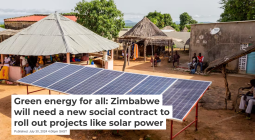Balcony Rails, Building Exteriors the ‘Newest Frontier’ for Solar

Seizing on the chance to lower energy bills, support a local business, and help build the green economy, owners of a 1960s-era apartment building in Toronto are updating its balcony railings with balustrades containing built-in solar panels.
Building-integrated photovoltaics (BIPV), the “newest frontier” in solar, are appearing on buildings in Canada and around the world, and an Etobicoke company is leading the way, reports the Toronto Star.
“This is the green economy in action,” Stephen Job, vice-president of Tenblock, a sustainability-minded developer that advised the building owners on the project, told the Star.
“It’s a simple thing that fulfils its core purpose, which is safety for residents, and it has this really interesting upside: It’s going to be a little better for our business, a little bit better for the planet, and it supports a local manufacturer.”
Safety codes require that balcony railings be replaced every 20 years, so this is something building owners plan for. “This is an investment that had to be made and we had a chance to put some topspin on it, both for the planet and for the business,” Job said.
While the balustrades with solar panels were “a little bit more expensive” than ordinary glass, installation “comes with a 25-year performance warranty, ensuring the upgrade will pay for itself several times over,” the Star says.
Installation of the BIPV balustrades throughout the building will be finished by November. Upon completion, more than 1,200 linear metres of photovoltaics will be in place, providing an estimated 100 megawatt/hours of power annually, or roughly 7% of the building’s operational use (excluding the power used by tenants).
BIPV can be made to resemble a wide range of materials and can be put anywhere.
Tenblock sourced its BIPV from Etobicoke-based Mitrex, North America’s largest manufacturer of building-integrated solar cladding.
In the cladding business for the past 20 years, Mitrex produced its first BIPV panels in 2021. It has since installed the technology on buildings around the world, including a student residence at St. Mary’s University in Halifax, Nova Scotia, and an office building in Dubai. The University of Toronto, Scarborough has contracted to use Mitrex BIPV on a new medical building.
BIPV is a boon to those looking to make the switch to solar who are strapped for space.
“If you look at a city, the land is extremely expensive,” Mitrex founder and CEO Danial Hadizadeh told the Star. “Facades are free. No one’s using them. They’re just sitting there.”
Meanwhile, balcony solar of a different sort is all the rage in Germany where more than half a million plug-in, balcony-based solar panels have been installed to date.
The panels aren’t going to lead to energy independence—they typically produce “only enough electricity to charge a laptop or small refrigerator,” reports the New York Times. But they require neither expert know-how nor tools to install.
The plug-in systems are also cheap, with individual panels selling for about €200, or about C$300.
The Times identifies a further driver as the desire to make a difference in the fight to rein in global heating, particularly amongst young people with children.





